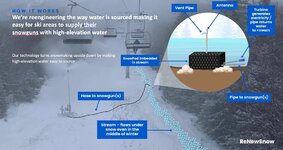thebigo
Well-known member
Is 75 gpm max or typical?
Is 200 psi measured at the pump or nozzle?
For the sake of this discussion, water is incompressible. Pressure is required to overcome flow loss only.
The reservoirs are buried under water bars, a 20,000 gallon tank is roughly 60' long. The reservoirs refill naturally or a resort can chose to refill at their discretion. Those in the industry are more knowledgeable than I but my understanding is that utility rates fluctuate?
Is 200 psi measured at the pump or nozzle?
For the sake of this discussion, water is incompressible. Pressure is required to overcome flow loss only.
The reservoirs are buried under water bars, a 20,000 gallon tank is roughly 60' long. The reservoirs refill naturally or a resort can chose to refill at their discretion. Those in the industry are more knowledgeable than I but my understanding is that utility rates fluctuate?
Last edited:

